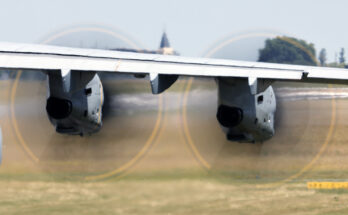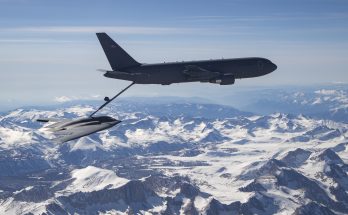
On October 24th, a People’s Republic of China (PRC) J-11 fighter came within 10 feet of a U.S. B-52 bomber during an intercept in international airspace near the South China Sea, according to U.S. Indo-Pacific Command (USINDOPACOM). The news comes only a week after the Pentagon released a series of photos and video footage of some of the more than 180 concerning flight interactions between Chinese and American aircraft since 2021.
In the initial release, DOD officials were careful to describe the actions as “risky” and “concerning” but not unsafe. But within days, USINDOPACOM called the recent incident “unsafe and unprofessional.” The incidents are increasing in number, totaling more in the past two years than in the previous decade.
U.S. officials believe these dangerous interactions are part of a broader PRC strategy in the region. Ely Ratner, Assistant Secretary of Defense for Indo-Pacific Security Affairs, called the intercepts “a centralized and concerted campaign” intended to influence U.S. actions in the area.
Aside from China’s violation of aerial intercept norms and international aviation standards, the end state of this strategy is likely to result in disaster. The increasing rate of interactions, the razor-thin error margin of proximity flying between non-allied aircraft, and historical precedent suggest a near-certain risk of midair collision.
The Hainan Island Incident
The 2001 Hainan Island incident, which is receiving renewed attention, presents eerie similarities to current events. On April 1, 2001, a U.S. Navy EP-3 reconnaissance aircraft flying above the South China Sea collided with a People’s Liberation Army (PLA) F-8 fighter jet. Following the collision, the Chinese F-8 crashed into the water, killing the pilot. American pilots of the damaged EP-3 recovered control and made an unapproved emergency landing on China’s Hainan Island.
The U.S. Navy flight crew of 24 was questioned and detained for 11 days by Chinese authorities and released only after the U.S. delivered an explanatory letter to the Chinese government. The incident resulted in widespread media coverage and tense relations between the two nations. For the Bush Administration, the event was an early diplomatic crisis, ultimately resulting in a relatively fortunate conclusion given other possible and more likely outcomes.

Causal Factors
In the aftermath of the collision, both the U.S. and China assigned blame to each other. China maintained the pilots of the EP-3 aggressively turned into the fighter. The U.S. flight crew stated the fighter flew into the airplane while it conducted a predictable straight and level flight on autopilot. According to the Navy flight crew, the F-8 completed three intercept passes alongside the EP-3 and came within three to five feet of the aircraft. During the third maneuver, the F-8 struck the left outboard propeller of the EP-3, severely damaging the engines, radar, and fuselage. The impact reportedly destroyed the F-8 jet, breaking it in half and sending it into the water below. Some reports indicate the proximity of the aircraft caused the jet to become sucked into the propwash of the EP-3 engine.
A Congressional Research Service (CRS) post-accident analysis concluded, “Despite PRC claims that the EP-3 plane caused the accident, it appears that the PLA pilot, executing a close pass in an apparent attempt to impress or intimidate the EP-3 crew, made a fatal error in judgment.”
The Pentagon’s recent release shows PRC aircraft engaged in some of the same flight maneuvers as those conducted by the Chinese F-8 leading up to the 2001 collision. Photos and video from one event show a Chinese fighter jet conducting an intercept pass under an American aircraft, causing the U.S. pilots to lose visual contact. After the U.S. pilots sped up to open the distance between the two, the fighter returned on another pass and closed within 10 feet of the underside of the U.S. aircraft.
Risky Flying
Close proximity flight is inherently dangerous, even between aircraft of the same nation or type. The risk of collision increases when aircraft of different performance characteristics and sizes fly close. When an unknown aircraft approaches it’s difficult to discern the pilot’s intentions or anticipate future movements. There is a good reason why aircraft not engaged in planned formation flying avoid each other.
The Hainan Island collision occurred in the morning shortly after 9:00 AM local time. The October 24th interaction, where a PRC J-11 jet closed within 10 feet of a U.S. B-52, occurred at night in limited visibility conditions, according to U.S.-Pacific Command Public Affairs. It’s important to note the U.S. press release states, “We are concerned this pilot was unaware of how close he came to causing a collision.” Although Chinese aerial unprofessional intercepts are now considered a deliberate policy, the pilot’s inability to understand how close the aircraft came to colliding is deeply concerning.
Nighttime visual flight is more difficult and taxing on pilots than daytime operations. At night, visual acuity degrades, and reaction times slow. Peripheral information gathering is harder and even with night vision aids depth perception is dramatically reduced. In maneuvers like close passes and intercepts especially, the rate of closure or the speed at which two aircraft are approaching each other is much more difficult to realize than during daytime flight.
It is unlikely the F-8 pilot intentionally collided with the EP-3 aircraft. Based on the analysis and crew accounts, the repeated close-in approaches resulted in an uncontrollable situation where collision became inevitable. When conditions are brought to this point, whether deliberately or not, the ability to avoid becomes increasingly smaller and often beyond pilot control.
A Worrisome Pattern
Home nation intercepts of foreign aircraft nearing territorial airspace are routine and widely practiced. For decades, this strategic game has played out between Chinese, U.S., and allied aircraft operating in international airspace above the South China Sea with mostly uneventful interactions. However, in the months preceding the 2001 Hainan Island collision, China increased the rate of intercepts of American aircraft with escalatory flight maneuvers.
The CRS cited the growing aggressiveness of Chinese intercepts as an objective factor in the leadup to the Hainan Island accident. Secretary of Defense Donald Rumsfeld reported at an April 2001 press conference that since December 2000, U.S. aircraft were intercepted by Chinese aircraft 44 times before the collision on April 1st. Six of these intercepts involved Chinese planes approaching within 30 feet of American aircraft and two within 10 feet.
Over two decades later, the pattern of aggressive intercepts by Chinese aircraft has intensified. The Pentagon’s public declaration that the past two years have yielded more concerning aerial interactions than in the past decade is a worrisome signal in this historical context. The similarities between preceding events in 2001 and 2023 are too alike to dismiss. If the escalatory pattern, both in frequency and dangerous flight actions taken by Chinese fighters continues at this pace, it’s difficult to imagine a future catastrophe is not inevitable.
The 2001 Hainan incident could have easily proven fatal for the American crew and more disastrous for American-Chinese relations. If an accident were to occur now, the consequences are more dire. The 2001 CRS report references many of the same subsequent security implications also of great concern today. These include deteriorating relations between the U.S. and China, Japanese concerns about Chinese aggression, U.S. policy regarding Taiwan, U.S.-Chinese relations affecting South Korea, and Russia’s reaction to an incident.
In hindsight, the global pre-9/11 security environment seems far less complex than the one the U.S. faces today. With the ongoing conflict in Ukraine, the threat of greater military escalation in the Middle East, and a decades-long military buildup of peer competition with China, the stakes of an international incident in the Indo-Pacific region could prove to be calamitous. A mid-air collision and resulting loss of life represents the type of cataclysmic event military officials and defense analysts fear could initiate a U.S.-Chinese conflict over Taiwan. If the current trend continues, history suggests a similar incident is only a matter of time.
A former naval officer and helicopter pilot, Jon covers a range of Forecast International reports and products, drawing on his 10-year background in military aviation, operations, and education. His previous military assignments include multiple overseas deployments supporting operations in the Arabian Gulf, NATO exercises, and humanitarian missions. Jon’s work is also influenced by his time as a former Presidential Management Fellow and international trade specialist at the Department of Commerce.
Before joining Forecast International, Jon also served as an NROTC instructor and Adjunct Assistant Professor at the University of Texas, where he taught undergraduate courses on naval history, navigation, defense organization, and naval operations and warfare. A lifelong reader and learner, his academic and professional interests include aviation, political and military history, national defense and security, and foreign area studies.




